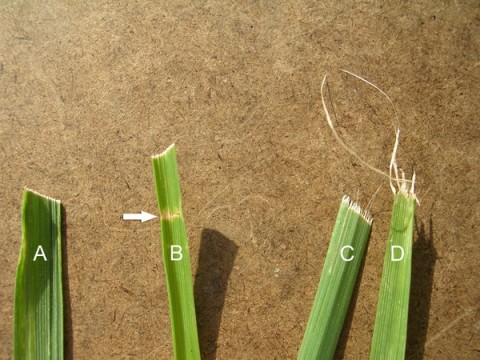A zero-turn mower is a great piece of equipment, and will help you mow large areas accurately in a short amount of time. But like many tools, if the blades are blunt on your zero turn mower it quickly becomes ineffective. In this guide we’ll discuss how to sharpen your zero turn mower blades.
Equipment You’ll Need:
- Bench Vice
- Hammer and nails
And Either:
- A Small Grinder / Bench Grinder or
- A Large Flat Hand File
Blunt Blades Can Brown Your Lawn

Sharp blades allow your mower to cleanly cut each blade of grass, not unlike a sharp pair of scissors. Blunt blades, however, will leave a messy rip-like cut which often goes brown. Compounded over a large area, this can give your lawn a brown tinge and leave you wondering why. Fortunately, sharpening your blades is a straightforward job, so it’s an easy fix!
Two Methods: File Or Grinder
There are two main approaches to sharpening your mower blades, and your choice will depend on the size of your mower, the amount of time you have, and the tools you have available.
For smaller or high-precision mowers, we recommend using a file to sharpen the blades. This approach can be a bit time consuming, but some people find it easier and it’s harder to damage the blades.
For larger mowers, we recommend using an small handheld or bench grinder to bring the blades to a sharp edge. This approach is certainly quicker, but you need to be careful you don’t remove too much material, and not everyone will have these tools at their disposal.
Approach 1: The File Method
Place your blade horizontally in a vice, with the cutting edge facing upwards and ideally towards you. Observe the angle the blade has been sharpened to, and using a large flat hand file, file along the length of the blade at the same angle. As with almost all sharpening, the goal is to re-hone the edge by removing material from the blade at the sharpening angle. It’s worth noting that mower blades don’t need to be knife-sharp, so you’re not looking to create the finest of edges. Once complete, repeat the process on the other side of the blade. If possible, try to remove the same amount of material – either by marking the blade using a sharpie, or counting the number of strokes you’ve take with the file.
Approach 2: The Grinder Method
Before you start any power tools, ensure you’re wearing the appropriate safety equipment: eye protection, ear protection, thick gloves and overalls. Sparks will fly, so make sure that the immediate area around you is clear and nothing flammable is nearby.
If you’re using a hand grinder, you’ll begin in much the same way as the file, by placing the blade horizontally into a vice. Again, observe the sharpening angle – that is the angle that material has been removed at to produce the sharpened edge. Using your hand grinder, work your way along the blade in smooth strokes, removing material at the same angle. Take care not to “bow” the blade by removing too much in the middle – keep it even along the length of the blade. Remember you don’t need to remove a huge amount of material – so don’t get too carried away. Once complete, turn the blade around and repeat on the other site.
If you have a bench grinder, the process will be slightly different. Since the grinder is fixed, you’ll be moving the blade smoothly backwards and forwards against the grinding wheel to remove material. Before you start, again remember to observe the grinding angle, and consider making yourself a small wedge or aid to put under the blade to hold it at a consistent angle. Make sure the blade is properly supported before you begin.
Balancing The Mower Blades
Once you’re happy you’ve sharpened both ends of the blade to a new edge, it’s time to check the blade is balanced. This is an important step – if you don’t do it, it’ll cause the blade to vibrate and damage your mower.
Hammer a nail into the wall or workbench horizontally, and balance your blade on it by putting the nail through the center hole. The blade should balance horizontally – if it tips to one side or the other, mark that side with a sharpie and remove a small amount of additional material. Re-check the balance and repeat this process until your blade is balances.
Conclusion
That’s it, you now have a nice sharp mower blade to fit back onto your zero turn mower. Remember to check all the bolts are tight when you mount it back onto the machine, and if you’re in any way unhappy we recommend contacting a professional garden tools servicing company.






